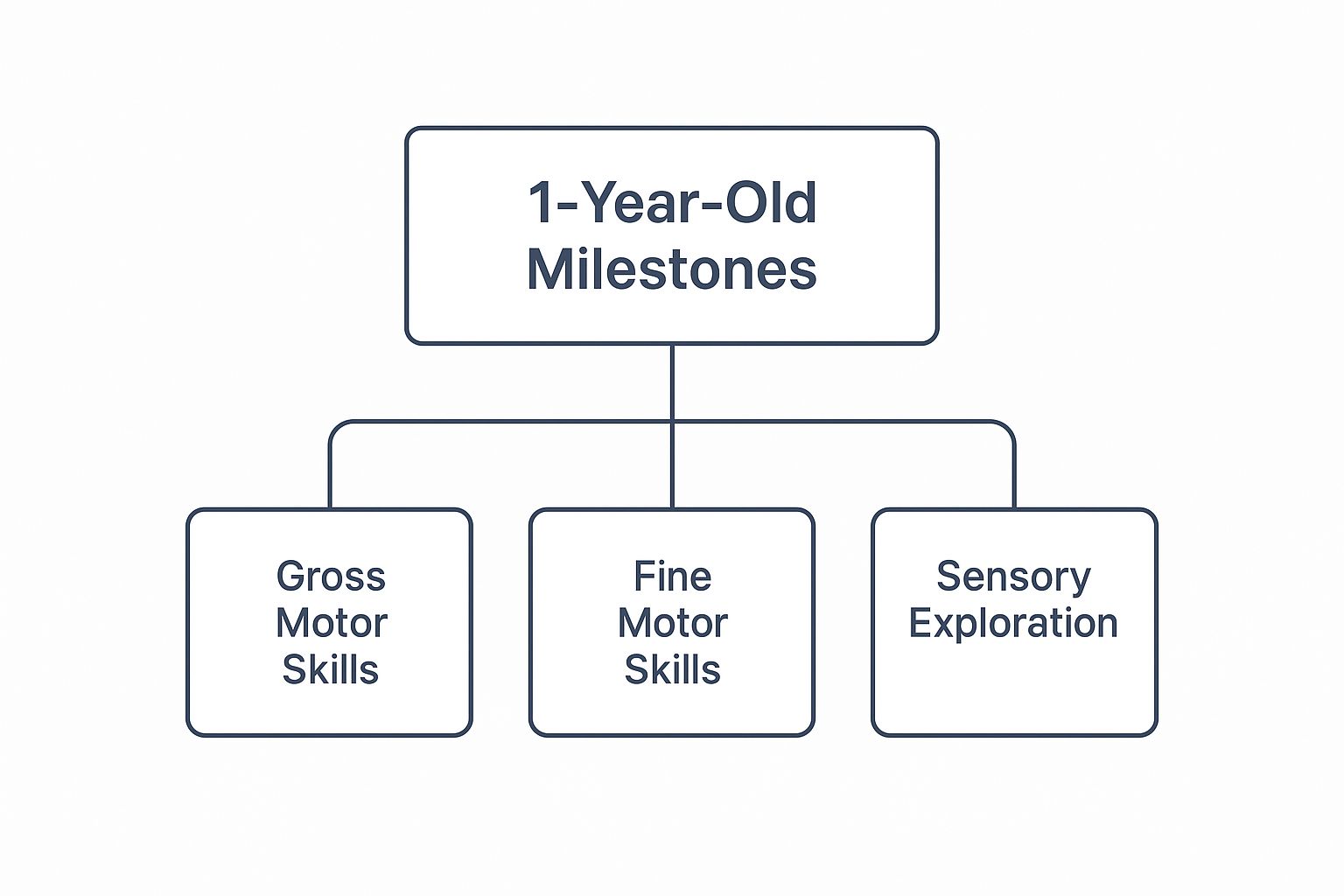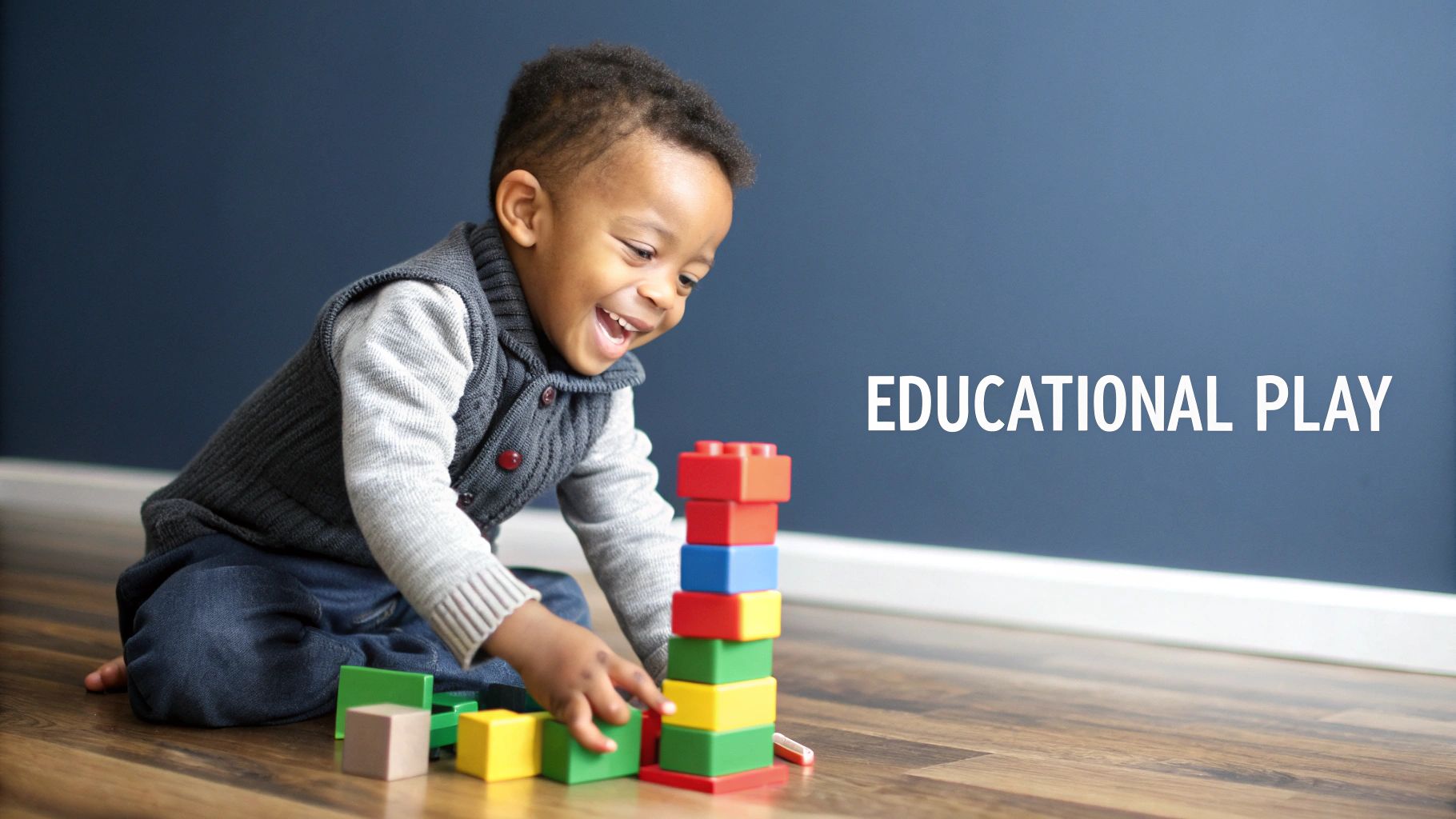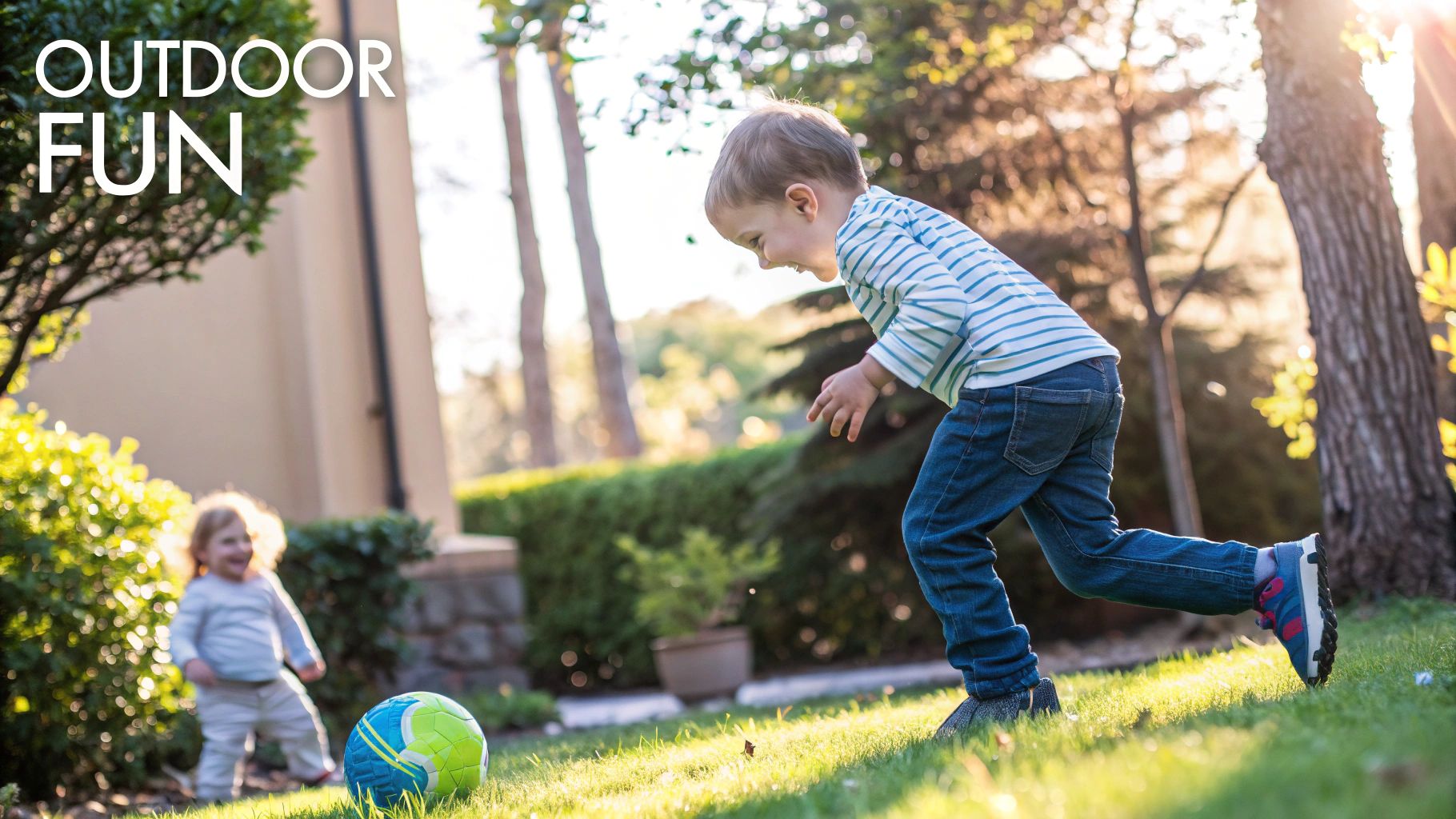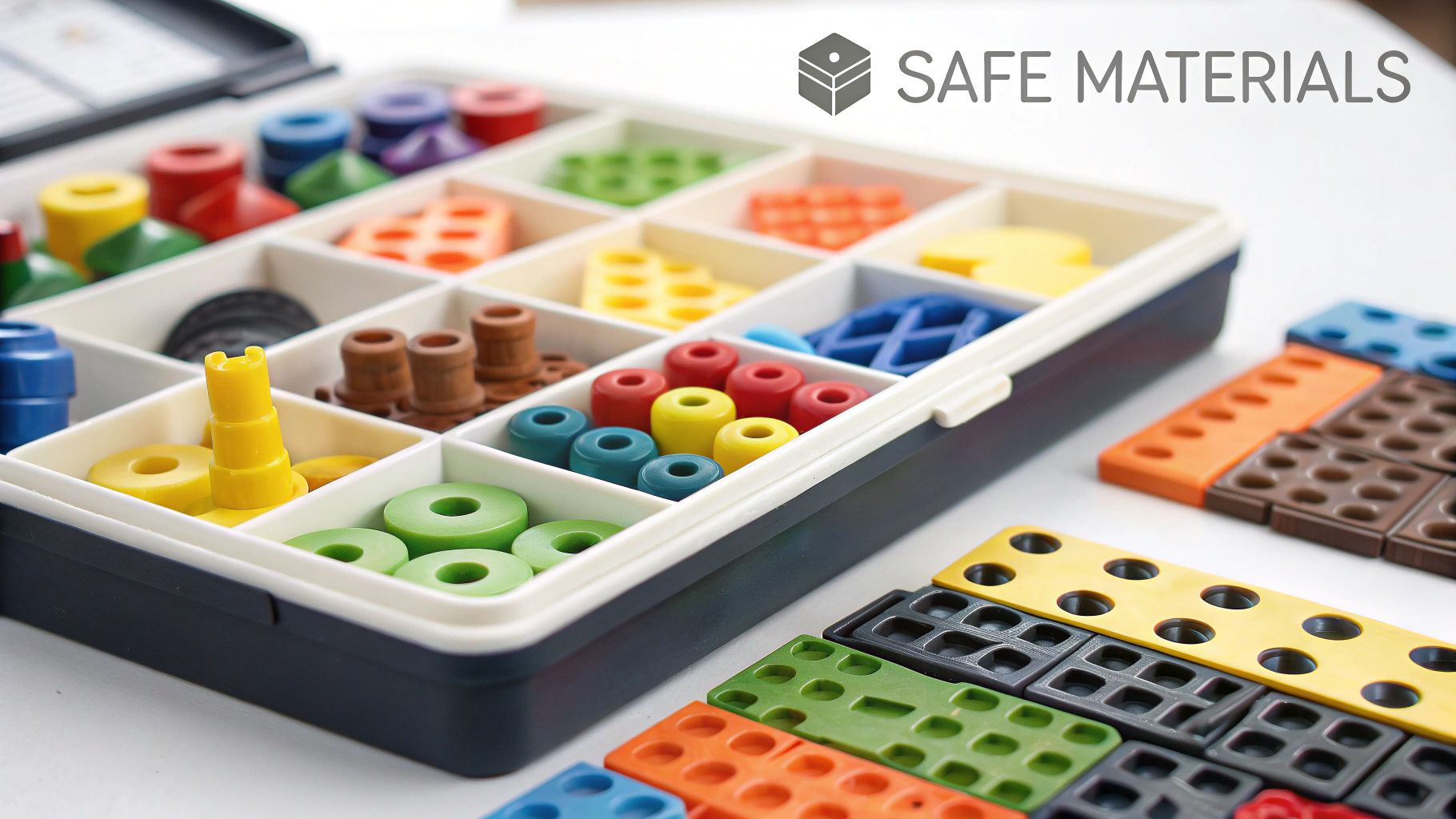
A Parent’s Guide to 1 Year Old Toys for Boys
Share
Choosing the right 1 year old toys for boys is all about matching the gift to his current stage of discovery. The best toys aren't just for fun; they support brand-new skills like walking, grabbing, and figuring out cause and effect. Suddenly, playtime becomes a powerful learning experience.
How to Find the Perfect First Birthday Gift
Walking into a toy store to find a first birthday gift can feel a little overwhelming. It's a maze of colorful plastic and wooden blocks. But the secret isn't finding the flashiest, noisiest toy on the shelf—it's finding the one that lines up with what he’s trying to master right now.
At one year old, a little boy is a tiny explorer, constantly testing his environment. Every object he touches, pushes, or tries to fit into another is part of a grand experiment to understand how his world works.
Think of toys as tools for his developmental toolkit. Just like a hammer is designed for a specific job, certain toys are perfectly built to help him strengthen specific skills. A push-toy isn't just a cart to zoom around; it’s a support system for his first wobbly steps, giving him the confidence to cruise around the living room. Those simple stacking rings are more than just colorful circles; they're his first real puzzle, teaching hand-eye coordination and the basics of how things fit together.
Matching Milestones to Toys
The best way to choose a great toy is to observe what he's fascinated with at the moment. Is he constantly trying to stand up and move? Is he intrigued by tiny objects he can pick up with just his thumb and forefinger? These actions are your biggest clues. They tell you exactly what his developmental priorities are.
This infographic breaks down the primary areas of development for a one-year-old: gross motor, fine motor, and sensory exploration.

As you can see, his growth isn't just happening in one area at a time. He's building skills across multiple domains all at once. When you understand these key milestones, you can confidently choose a gift that’s not only engaging but fundamentally important for his growth.
If you're looking for more ideas, our guide on the best gifts for toddlers is a great place to continue your search.
To make things even easier, the table below gives you a quick reference, connecting his developmental progress with the kinds of toys that will help him thrive.
Developmental Milestones and Corresponding Toy Types for 1-Year-Old Boys
| Developmental Area | Milestones to Expect | Recommended Toy Category |
|---|---|---|
| Gross Motor Skills | Pulling up, cruising, taking first steps | Push toys, low climbers, soft balls |
| Fine Motor Skills | Pincer grasp, stacking, turning pages | Shape sorters, large blocks, board books |
| Cognitive Growth | Object permanence, cause and effect | Stacking rings, simple puzzles, pop-up toys |
| Sensory Exploration | Exploring textures, sounds, and shapes | Musical instruments, textured balls, activity boards |
By focusing on these areas, you can be sure you're getting him a toy that will be played with long after the birthday cake is gone.
What a One-Year-Old Is Actually Learning Through Play

Ever wondered what's going on in the wonderfully chaotic mind of a one-year-old? Every single action is a little experiment, and every toy is a tool for discovery.
When a little boy gleefully knocks over a tower of blocks for the tenth time, he’s not just making a mess. He’s a tiny physicist testing the laws of gravity and cause-and-effect. That toy he constantly puts in his mouth? He’s a scientist gathering data on its texture, shape, and material. Play is his full-time job, and the skills he’s building now are the foundation for all future learning.
Once you understand the "why" behind his actions, you can see just how essential the right toys are for his development.
Gross Motor Skills: The Big Moves
Around his first birthday, your son is laser-focused on mastering major movements. He’s pulling himself up to stand, cruising along furniture, and might even be taking those first wobbly, independent steps. These aren't just physical milestones; they are huge cognitive leaps that build his spatial awareness and confidence.
Toys that encourage this movement are invaluable. Think of a simple push toy not just as a cart, but as a trusty partner that gives him stability while he builds leg strength and balance. In the same way, low, soft climbing structures offer a safe space to practice going up and down, developing coordination and problem-solving skills all at once. You can see exactly how a well-designed Pikler Triangle set supports this kind of active, independent play.
Fine Motor Skills: The Small, Precise Actions
While he’s busy making big moves, his brain is also working hard on the small ones. The ability to pick up a tiny piece of food with his thumb and forefinger—the famous pincer grasp—is a massive achievement in fine motor skills. This one skill is the building block for future tasks like holding a crayon and zipping up a jacket.
Simple, classic activities are fantastic for honing these skills:
- Stacking rings: These teach him to coordinate his hands and eyes to place an object right onto a target.
- Large wooden blocks: Just picking up, holding, and attempting to stack blocks strengthens all the tiny muscles in his hands.
- Shape sorters: This old-school toy challenges him to turn and manipulate shapes to make them fit—a surprisingly complex task for his developing brain.
Play is the highest form of research. It’s through these seemingly simple games that a one-year-old boy constructs his understanding of the physical world, one block and one step at a time.
This growing awareness among parents has fueled significant market growth. The infants and toddlers toy market, currently valued at around USD 16.7 billion, is expected to keep expanding as more parents look for toys that actively support developmental milestones. You can discover more insights about the growing educational toy market on gminsights.com.
Ultimately, choosing the right 1 year old toys for boys means you’re not just buying another plaything; you’re investing in his learning journey.
Your Essential Toy Safety Checklist

When you're picking out 1 year old toys for boys, safety isn't just a nice-to-have feature—it’s everything. At this age, a boy’s primary method of investigation is his mouth. Every single object is destined to be chewed on, dropped, thrown, or shaken vigorously. Your new job title? Lead Safety Inspector.
This might sound a little intense, but it’s actually pretty straightforward. You don't need a lab coat or a clipboard. Just by focusing on a few key details, you can quickly spot the common hazards and make sure playtime stays fun and injury-free.
Think of yourself as a detective on the hunt for clues. Your first and most important clue is the toy's size. For kids under three, small parts are the number one risk. Luckily, there's a simple, low-tech way to check for choking hazards: the "toilet paper roll test."
If a toy—or any piece that could break off it—can fit entirely inside an empty toilet paper roll, it’s a no-go for a one-year-old. It’s a surprisingly effective trick for gauging what could be a serious choking risk.
This test is your non-negotiable first step. It’s a quick check that can prevent one of the most common toy-related injuries for young children.
Checking Materials And Construction
Once you’ve cleared a toy for size, it’s time to look at what it’s made of and how well it’s put together. Since you know it’s going in his mouth, you want to be certain that what he’s gumming is completely safe.
-
Look for Safe Materials: Stick to toys made from solid wood with non-toxic, lead-free paint. If you’re going with plastic, look for labels that explicitly state it's BPA-free, phthalate-free, and PVC-free. This ensures that even if he’s teething on it for an hour, he isn’t ingesting nasty chemicals. The same logic applies to other items in his environment, a topic we explore more in our guide to non-toxic kids furniture.
-
Inspect for Durability: Run your hands over the toy. Are there any sharp edges, points, or potential splinters? Give it a good tug. Parts like wheels, teddy bear eyes, or buttons should feel like they're attached for life, not ready to pop off.
-
Avoid Cords and Strings: This one is simple. Any toy with a string, cord, or ribbon longer than seven inches can be a strangulation hazard. Just steer clear of them entirely at this age.
The U.S. Consumer Product Safety Commission (CPSC) provides some really clear, visual guidance on this.

This graphic drives home the most important points: always check age labels and make sure the toy is built to last. Making these quick checks a habit will give you peace of mind, creating a truly safe space for your little guy to explore, learn, and just be a kid.
Top Toy Categories That Fuel Development and Fun

When you're picking out 1 year old toys for boys, it helps to think beyond just what looks fun and consider the "why" behind each choice. At this age, play is serious business. Every toy category is like a different station at his own personal gym, each one targeting specific developmental muscles.
So instead of just buying random toys, think of it as building a hand-picked collection of tools to support his growth. By grouping toys based on the skills they build, you can make sure he has a well-rounded toolkit for all his exploring. Let's dig into the categories that really make an impact.
Movers And Shakers For Gross Motor Skills
At one year old, a little guy is on a mission: to move. His entire world is opening up as he learns to pull himself up, cruise along the sofa, and take those wobbly first steps. Toys that get behind this physical journey are huge for building his confidence and coordination.
Push toys are a classic for a reason. They offer the perfect amount of stability for a new walker, acting as a trusty sidekick that helps him work on his balance and strengthen those little leg muscles. They give him the freedom to explore on his own terms.
- Push Walkers: Look for ones that are sturdy and well-weighted so they won't tip over easily when he leans on them.
- Ride-On Toys: Low-to-the-ground toys he can push with his feet are fantastic for developing leg strength and figuring out how to navigate around things.
- Soft Balls: Even a simple, lightweight ball encourages him to crawl, chase, and eventually kick, which is great for his core strength and coordination.
Little Thinkers For Problem Solving
While his body is on the move, his mind is firing on all cylinders, trying to figure out how everything fits together. Toys in this category are his first real introduction to logic, spatial reasoning, and problem-solving. They challenge him to think, handle objects, and connect cause and effect.
A shape sorter, for example, is so much more than just putting blocks in holes. It teaches him to spot the difference between shapes, turn objects to find the right fit, and feel that little spark of victory when it works. It’s a tiny exercise in building resilience and critical thinking.
This emphasis on skill-building is a huge deal in the toy industry. The global market for baby and toddler toys, valued at around USD 24.5 billion, is growing fast precisely because of this focus on educational play. You can find more insights on the booming developmental toy market at gminsights.com.
Budding Builders For Spatial Awareness
Big, chunky blocks are fundamental for a one-year-old. He might not be building elaborate castles just yet, but the simple act of stacking them—and more often, knocking them down—is a powerful lesson in basic physics. He’s learning about balance, gravity, and cause-and-effect in the most hands-on way possible.
Just holding and placing blocks helps fine-tune his hand-eye coordination and spatial awareness. He’s learning how much space an object takes up and how to place one on top of another, a skill that takes a ton of concentration for his small hands.
Sensory Explorers And Early Pretenders
A one-year-old’s senses are his main tools for gathering information. Toys that engage his sense of touch, sound, and sight help forge strong connections in his brain.
- Textured Balls: Balls with different bumps, ridges, and fabrics give his hands plenty of interesting tactile feedback to process.
- Simple Musical Instruments: A small xylophone or a set of shakers introduces him to cause and effect through sound. Hit this, get that!
- Toy Phones or Remotes: These tap into his growing desire to copy the adults around him, laying the very first bricks for imaginative play and social skills.
By offering a mix of toys across these key areas, you create a rich learning environment. You're not just filling a toy box; you're equipping a little explorer for his incredible journey of discovery.
Choosing Toys That Grow with Your Child
How do you pick a toy that won't be gathering dust in a corner after just one week? The real secret is choosing toys that can adapt as your little guy gets older and his skills develop. Instead of getting caught up in flashy features, I always look for items that offer lasting value by challenging him in new ways over time. You'll find the best 1 year old toys for boys are often the simplest ones.
A great way to figure out a toy’s staying power is to think about its potential for open-ended play. This just means the toy doesn’t do one single thing; it invites your child to get creative. A set of plain wooden blocks is the perfect example. Right now, he might just love banging them together or watching you knock them over. In six months, he’ll be stacking them into wobbly towers all by himself, and before you know it, he'll be using those same blocks to build bridges and roads for his cars.
The Power of Passive Toys
I like to think of toys as either "active" or "passive." An active toy, like one of those electronic learning tablets, really does most of the work. It has buttons that sing songs or light up, basically telling your child how to play. But a passive toy, like our wooden blocks, does absolutely nothing on its own. It needs your child’s imagination and action to bring it to life.
For a one-year-old, passive toys are absolute developmental powerhouses. They get those little gears turning, encouraging problem-solving, creativity, and independent thought in a way that most active toys just can't.
This growing understanding among parents has had a huge impact. The global baby toys market hit around USD 14.13 billion in 2023, partly because parents are looking for high-quality, educational toys that do more than just distract for a few minutes. You can dig into more insights about the expanding baby toy market on verifiedmarketreports.com.
Longevity, Engagement, and Interest
To find these long-lasting gems, I use a simple little framework. I just ask myself three quick questions before I even think about buying:
- Longevity: Can this toy be used in new, more complex ways as he gets older? A simple ball is a great test. First, he'll learn to roll it, then to throw it, and eventually to kick it.
- Engagement: Is it an open-ended toy that will spark his imagination? Think about a set of stacking cups. They can be hats, drums, or towers—whatever he dreams up.
- Interest: Does it tap into what he's fascinated with right now? If he's obsessed with opening and closing every door in the house, an activity board with different latches will be a massive hit.
The goal isn't to fill a room with toys, but to curate a small, thoughtful collection. Rotating just a few high-quality items keeps playtime fresh and prevents overstimulation, ensuring your investment pays off in months of meaningful play, not just minutes.
Of course. Here is the rewritten section, crafted to sound like it was written by an experienced human expert.
Frequently Asked Questions About Toddler Toys
It’s easy to get bogged down with questions when you’re navigating the world of toddler toys. You start worrying about creating too much clutter, or maybe you feel stuck on old-fashioned ideas about what playtime should look like.
Let’s clear the air. Here are some practical answers to the most common concerns parents have about choosing 1 year old toys for boys. This is less about following strict rules and more about understanding how your little guy really interacts with the world around him.
How Many Toys Does a 1 Year Old Boy Really Need?
Honestly? Less is more. A small, thoughtfully curated collection of 8-10 high-quality, open-ended toys is so much better than a room overflowing with stuff. Too many options can quickly overwhelm a young child, and you’ll find they don’t actually play with most of it.
The goal isn't a mountain of toys, but a variety of experiences. Make sure his little collection covers the key developmental bases. He should have:
- Something to push or move around for those developing gross motor skills.
- Something he can stack or build to work on fine motor control.
- Something to sort, which is the beginning of problem-solving.
- Something for that budding imagination, like a simple toy phone.
A fantastic and simple strategy is to rotate his toys. Pack a few away every couple of weeks. When you bring them back out, they’ll feel brand new to him, which keeps him engaged and prevents that dreaded overstimulation.
Should I Avoid So Called Girly Toys For My Son?
Definitely not. At this age, play is all about discovery and skill-building, not about conforming to gender stereotypes. Toys are just tools for learning, and you can actually hold back your son's development by limiting his options based on the color of the box.
Take a play kitchen, for example. It’s an amazing tool for any toddler. It sparks pretend play, helps build vocabulary ("cup," "apple," "stir"), and sharpens fine motor skills as he "chops" veggies or opens and closes little doors.
The same goes for dolls or stuffed animals—they’re fantastic for building empathy and social-emotional skills. A truly rich play environment is one filled with a wide variety of toys, no matter what aisle they came from.
Are Electronic Toys Bad For My Child?
They aren't "bad" in and of themselves, but they need to be balanced with good old-fashioned passive toys. The toys that deliver the biggest developmental punch are often the simplest ones—think blocks, balls, or stacking cups—that demand a child to get creative and physically involved.
Electronic toys can be fun, but they also carry the risk of being overstimulating. They often dictate the play with specific lights and sounds, which can do the imaginative "work" for your child instead of letting his own mind do it.
Think of those flashy electronic gadgets as a "sometimes" treat, not a playtime staple. That way, you ensure he’s spending most of his time deep in the kind of imaginative, hands-on play that truly fuels a growing mind.
At Ocodile, we believe in creating tools for a child's journey of discovery. Explore our collection of safe, beautifully crafted furniture designed to support your child's independence and make every moment of play a meaningful one. https://ocodile.com









